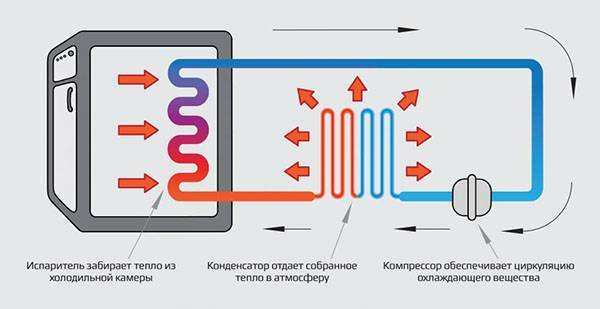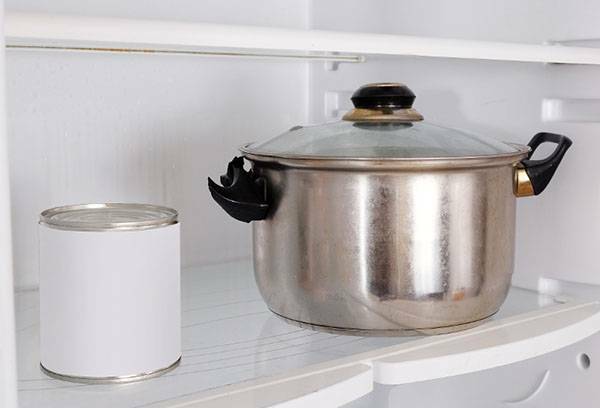Contents:
- How does your refrigerator work?
- What happens when you put hot in the refrigerator?
- Hidden threat
And you, too, out of habit, vaccinated since childhood, never put a chicken that has just been taken out of the stove, into the refrigerator? Usually we wait, checking if the dish has cooled enough, but suddenly all these years we were deceived and it turns out that it is still possible to put hot in the refrigerator. The portal "MissChistota" decided once and for all to deal with this issue!

How does your refrigerator work?
To understand exactly what you're risking, putting the soup you just removed from the stove in the refrigerator, you need to at least a little understanding of how this refrigerator works. In today's market, models are mostly represented either with a no frost system or with a drop cooling system. What exactly happens when you put a hot soup in the refrigerator depends on the type of system used in your technique.
At the same time, two of the most important indicators that need to be talked about in this situation are the high temperature of that very pot and the steam that comes from any product "from the heat with the heat."
- No Frost
Moisture: Such refrigerators do not need to be thawed for one simple reason: they drain all excess moisture by a well-thought-out ventilation system, that is, the liquid does not even have time to settle on the walls in the form of condensate and even more so frost.
Heat: The compressor works, cooling the camera to the set temperature, and then turns off. Work again, it begins when the temperature becomes warmer than the set temperature.
By the way
The compressor works only 10-20% of the time and is calculated approximately for this load.
- Drop system
Moisture: Refrigerators with a drop system also do not defrost, but not due to ventilation, but due to a kind of auto-defrost. That is, the moisture accumulates in the form of condensate on the rear wall, turning into frost, but when the compressor turns off, the frost melts, draining into special containers, where the moisture evaporates.
Heat: The temperature mode in the chamber is maintained in the same way as in the no frost system.
So, as the refrigerator is arranged, like, it is clear. But what does this give us?

What happens when you put hot in the refrigerator?
Depending on the refrigerator unit, the refrigerator systems will react differently to hot food, although there are several other factors that need to be taken into account.
- No frost
Moisture: This system determines the moisture level in the chamber, and its task is to maintain the humidity level within the acceptable limits. When you put the hot food from which the steam comes, into the refrigerator, the humidity level rises and the sensors detect it. Fans will work until the indicators are normalized, and if the soup is not covered with a lid, it will last for hours, which is not the norm.
Heat: There are also temperature sensors that cause the compressor to turn on and cool the camera to the set temperature. A hot tank, even a sealed one, will force the compressor to run until it can achieve a certain temperature in the chamber. This, given the rapid cooling of the hot pot, will last very, very long.
- Drop system
Moisture: In this situation, the steam will begin to settle on the rear wall, forming a thick layer of frost, which does not occur under normal conditions. Of course, ice build-ups, as in Soviet refrigerators, you will not see, and the hoarfrost will melt immediately, as the compressor turns off.
Heat: In general, the situation is the same as with no frost, only worse. The ice "coat" on the rear wall creates a layer of thermal insulation, so the compressor will have to work even longer, since it will be more difficult to achieve the desired temperature.
Why is it considered that pots can not be removed from the cooker in the refrigerator? Judge for yourself: if you regularly put hot in the refrigerator, the compressor and fans, if they are, will work without ceasing! True, most people resort to this step only in emergency cases, which means that the risks will depend only on the quality of the equipment and the degree of heating of dishes and food.
By the way: If you have a chance to at least give food a little cooling - do it. Each degree is a superfluous compressor running time, so warm foods are less dangerous than hot ones. Also, warm soup generates less steam than hot soup.

The latent threat of
To doubt whether you can put a hot pot in the refrigerator, other factors can force you. At the same time, given the relative survivability of compressors( especially imported ones), they can become a much stronger argument against hot in the refrigerator than the risk of breakage.
- Sharp temperature changes can spoil the dish, as some coatings, like ceramics or Teflon, either start to crack, or lose properties under such conditions.
- Temperature difference is dangerous for shelves: glass without the use of a stand under the pan can burst, and the plastic will begin to melt or crack.
- The worst thing in this regard is the deformation of the insulation around the perimeter of the door under the influence of heat. Such an elastic band will not be able to ensure the tightness of the chamber, and this will lead to an increased temperature, increased operation of the compressor on an ongoing basis and its imminent breakdown.
- Under the influence of even a warm container, plastic and rubber spoil, let alone the neighboring food! Most of all from this neighborhood, dairy products, vegetables and fruits will suffer.
- Surprisingly, many cooks claim that temperature changes adversely affect the shelf life of the dish itself. Thus, it has been proved by experience that a hot or warm soup, placed in a refrigerator, is stored much less than naturally cooled. The same goes for many desserts.
- If you want to solve the problems of removing moisture with a sealed lid, this can greatly affect the taste and aesthetics of the product. So, the condensate on the walls of the container will make any baking completely unappetizing, as the dough will get wet, having absorbed it.
- Well, another thing: a compressor that has been working for a long time, it's also additional electricity, which means that extra rubles in the account for utilities.
That's not so dangerous once to put the hot in the refrigerator, but after all this information is somehow do not want to. All the same, when you cool the dish beforehand, you care not only about the safety of the refrigerator, but also about the taste of food, the service life of the dishes and the thickness of your wallet!
